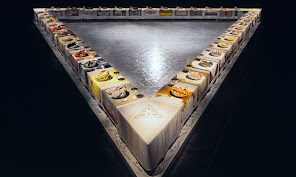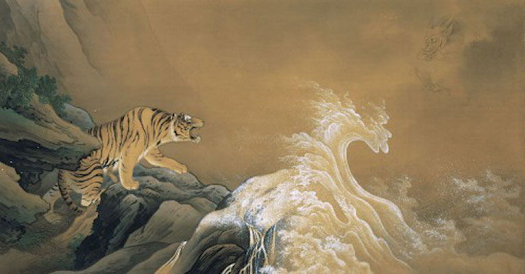Postmodern Art
Around the 1960s, artists began to react against Modernism, and as a result, Post Modern art was born. Where Modernism was centered around idealism and reason, Postmodernism challenged notions of universal truths through skepticism and a suspicion of reason. Postmodernism is not defined by a specific style; in fact, a cornerstone of postmodernism is its refusal to accept rules and definitions regarding what art should be. Thus, the unifying aspect of art from this era is its non-traditional approach.
The non-traditional approach that defines Postmodernism was influenced in part by the social happenings of the era. The Vietnam War was a point of contention during the 1960s. After World War I and II's devastations, many people wanted the world to exist in peace, not war. Students on college campuses across America began protesting the Vietnam War. Around the same time, the Civil Rights movement was gaining ground. Congress passed the Civil Rights Act of 1964, which prohibited discrimination based on race, color, religion, sex, or national origin. Parts of society had adopted a non-traditional and anti-authoritarian attitude, and postmodernist art reflected this spirit.
Up to this point, the Western art world had mostly been dominated by white males. With the changes in society's traditional beliefs, the Postmodernism era saw diversity in the art world increase, to include more women and people of varying ethnic backgrounds. Accordingly, I will showcase six works from the Postmodern era created by women.
Judy Chicago


The Dinner Party by Judy Chicago
. 1974-79. Ceramic, porcelain, textile. 576 x 576 in. America.
The Dinner Party is an
iconic feminist work. There are 39 place settings at the triangular dinner ceremony. Each place setting and banner represents an important woman from history and her achievements, like Sacajawea, Susan B. Anthony, and Emily Dickinson. The names of another 999 women are inscribed on the white tile floor.
Each plate is unique to the woman it is honoring, so the varying color palettes used on each plate are detail-oriented and important to the work as a whole. In addition, The shape of
The Dinner Party is notable as
triangles are a symbol of equality. This is a large installment, measuring 576 x 576 inches or 48 x 48 feet. The amount of space that this work occupies helps it make its statement. I find this to be an inspiring installation. This work encourages one to appreciate the women who have paved the way for modern women and to consider what achievements are yet to come.
Driving the World to Destruction by Judy Chicago.
1985. Acrylic and oil on Belgian linen. 108 x 168 in. America.
This is part of a larger collection of related works created by Chicago called
PowerPlay. The series examines the gender construct of masculinity and offers a critical take on patriarchy. Here, an exaggeratedly muscular male grips a steering wheel, a symbol of uncontrolled patriarchal power. This is partly based on Chicago's view of Renaissance art, where she noted that men were always portrayed as the heroes.
Color stands out in this work; the red and yellow give an ominous feeling of destruction, and the color palette used on the man makes him appear almost translucent. In the same vein, the use of value adds depth and points of interest throughout the piece. The strange shapes that compose the man's muscles add an unsettling feel. Overall, I think this is an interesting work that makes a strong statement; it is confrontational and I imagine it is fascinating to see it in real life alongside the other works in the collection.
Judith Baca
The Great Wall of Los Angeles by Judith Baca. 1974. 2,754 ft. America.
The Great Wall of Los Angeles is a monument to inter-racial harmony, representing the history of the ethnic peoples of California from prehistoric times up to the 1950s. Baca wanted the wall to showcase the "women and minorities who were so invisible in the conventional textbook accounts." The wall
employed over 400 youth and families from diverse social and economic backgrounds.
Pictured above are just two sections of the large mural. The bright, vivid colors stand out the most on this mural. The varying tones used throughout help to keep the images from looking too flat. The way that space is utilized allows the different sections of the timeline to flow together seamlessly. This mural is informative, and I appreciate how it focuses on minorities and women. It is incredible how large this project was and how the paintings still look fantastic.
Hitting the Wall by Judith Baca
. 1984. 20 x 100 ft. America.
This mural was commissioned for the 1984 Olympics, recognizing female marathon runners. It features a female runner crossing the finish line with arms outstretched, bursting through a brick wall. I believe this was intended to be in reference to a phenomenon where runners "
hit a wall," or experience a sudden drop in energy during a race.
The contrast of the bright blue and vibrant orange makes this mural stand out. There are inverted triangles in the center, which helps draw the eye to the center and subject matter of the mural. The form of the bricks and some of the wood pieces make it appear as if pieces of the mural are flying off the wall. I love that this mural empowers and honors female athletes. It gives off a satisfying sense of victory and perseverance.
Mary Beth Edelson
Some Living American Women Artists by Mary Beth Edelson,
1972. Lithograph on paper. 28 1/4 x 43 in. America.
Death of Patriarchy / Heresies, by Mary Beth Edelson.
1976. Lithograph on paper. 27 3/8 x 37 in. America.
These are collages in which the artist pasted heads of notable female artists over top of the men's faces in the original works. Some Living American Women Artists is an image of Leonardo Da Vinci's The Last Supper, and Death of Patriarchy / Heresies includes an image of John Trumbull's The Battle of Bunker's Hill, June 17, 1775. These works not only challenge the male-only painting club, but they also confront the subordination of women in religion and patriarchy in America.
The contrast of the black and white pasted on heads against the colors of the original art helps the alterations stand out. The placement of the female's heads matches that of the originals, and the heads match quite well in scale as well. Although these collages send confrontational messages, they are also a bit comical, which I enjoy.
References
"Postmodernism." Tate. https://www.tate.org.uk/art/art-terms/p/postmodernism#introduction
"Protests and Backlash." PBS: American Experience. https://www.pbs.org/wgbh/americanexperience/features/two-days-in-october-student-antiwar-protests-and-backlash/
"Legal Highlight: The Civil Rights Act of 1964." U.S. Department of Labor. https://www.dol.gov/agencies/oasam/civil-rights-center/statutes/civil-rights-act-of-1964#:~:text=In%201964%2C%20Congress%20passed%20Public,hiring%2C%20promoting%2C%20and%20firing.
"The Dinner Party by Judy Chicago." Brooklyn Museum. https://www.brooklynmuseum.org/exhibitions/dinner_party/
"Judy Chicago," The Art Story. https://www.theartstory.org/artist/chicago-judy/
"PowerPlay (1982-87)." Judy Chicago. https://judychicago.com/gallery/powerplay/pp-artwork/
"The Great Wall of Los Angeles." Judy Baca. https://www.judybaca.com/art/great-wall-of-los-angeles-1974-present/
"Hitting the Wall." Judy Baca. https://www.judybaca.com/art/hittingthewall/
"How to avoid hitting the wall." Runner's World. https://www.runnersworld.com/uk/training/marathon/a774858/how-to-avoid-the-wall-and-cope-if-you-hit-it/
"Mary Beth Edelson." Museum of Modern Art. https://www.moma.org/collection/works/117141










Hello Lacey,
ReplyDeleteFirst, I should point out here that I am a proud feminist who grew up in the 60s and 70s. Except for the Driving the World to Destruction picture I loved all the pieces you picked. I really can’t pinpoint one thing I didn’t like about it except the way they painted the muscles of his body.
The Dinner Party. I would love to examine each place setting, then read the other 999 names written on the tile floor. Reading about women who played a part in changing the world for women is one of my favorite past times. It was not lost on me that the way the inverted triangular shape the tables were laid out in stands for female reproduction.
Although I was born and raised in central California, I don’t recall hearing about The Great Wall of Los Angeles. However, it does look like an interesting work that really represents the entire state. It was and still is a melting pot of ethnicities. That is the one thing I always admired about my home state.
I really admire the considerable ingenuity of Mary Beth Edelson for creating Some Living American Women Artists and Death of Patriarchy/Heresies.